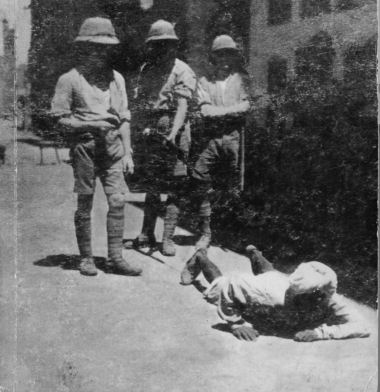|
Amritsar uprising 1919
The
Amrtisar Massacre and the 1/25th Londons involvement.
Faced
with insurrection in support of Mahatma Gandhi, the British Army declared
martial law. Violent rioting in Amritsar brought the Brigadier-General
Dyer to take astonishing action, including the shooting of over several
hundred unarmed people at a public meeting. This killing of unarmed Indian
protesters in the Punjab city of Amritsar, and the degrading martial law
which followed, is one of the most ignominious episodes in the history of
British imperial rule. Graphically recaptured in the film Gandhi, the
massacre fuelled post-war Indian (especially Muslim) resentment at British
control, and paved the way for the growth of support for Gandhi's
independence movement.[1]
The Jallianwala Bagh Massacre, also
known as the Amritsar Massacre, was named after the Jallianwala Bagh
(Garden) in the northern Indian city of Amritsar where, on April 13, 1919,
British Indian Army soldiers under the command of Brigadier-General
Reginald Dyer opened fire on an unarmed gathering of men, women and
children. The firing lasted about 10 minutes and 1650 rounds were fired,
or 33 rounds per soldier. Official British Raj sources placed the
fatalities at 379. According to private sources there were over 1000
deaths, with more than 2000 wounded, and Civil Surgeon Dr. Smith indicated
that there were 1,526 casualties.[2]
The composition of the
special force that day, one carefully chosen by Dyer, is significant. It
had no British soldiers, and most of its Indian troops nationalities
foreign to India or recruited from its fringes. A local businessman,
Girdhari Lal, stated that he saw the force leave Ram Bagh, and describes
them as Gurkhas and 'Baluchees'.[3]
Whilst a contingent of
100 from the 1/25th London Bn. were deployed as part of the general force
to put down the uprising, as can be seen from the above, they were not
involved in the subsequent massacre. I am sure that the descendants and
families of the Londons are, like myself, relieved to know this. However
Sgt. Anderson did witness the massacre as he was one
of General Dyer's bodyguards, and was present with the General.
See
the full 1/25th Londons account from the book :- '25th
County of London Cyclist battalion'.
See further photos of the uprising taken by an
unidentified soldier.
Centenary article.
Further
reading on the Amritsar uprising, massacre, historical background, and
subsequent enquiries, can be found in numerous publications.
- Punjab
disturbances, April 1919; compiled from the Civil and military gazette (Internet
Archive - 5.3MB)
- Punjab Disturbances 1919-20 Vol. 1 (Internet
Archive - 15.5MB)
- Punjab Disturbances 1919-20 Vol. 2 (Internet
Archive - 29MB)
- There
is a good page on Wikipedia.
- 'The Butcher of Amritsar: General
Reginald Dyer' by Nigel A. Collett.
- 'The Amritsar Massacre' by Alfred Draper.
- Books available from Bookfinder
& Amazon.
-
see also publications page.
|
One of the punitive measures taken by Dyer was the infamous
"Crawling Order", where Indians were forced to crawl
along the lane where Miss Sherwood had been attacked by the
rioters.
(Photo)[4]
Soldiers of the 25th London enforcing the
'Crawling Order'.
|

|
Source
acknowledgments :-
1. Amazon.co.uk - review
by Miles Taylor
2. Wikipedia
- Jallianwala Bagh Massacre
3.
'The Butcher of Amritsar: General
Reginald Dyer' by Nigel A. Collett.
4. National Army Museum
|